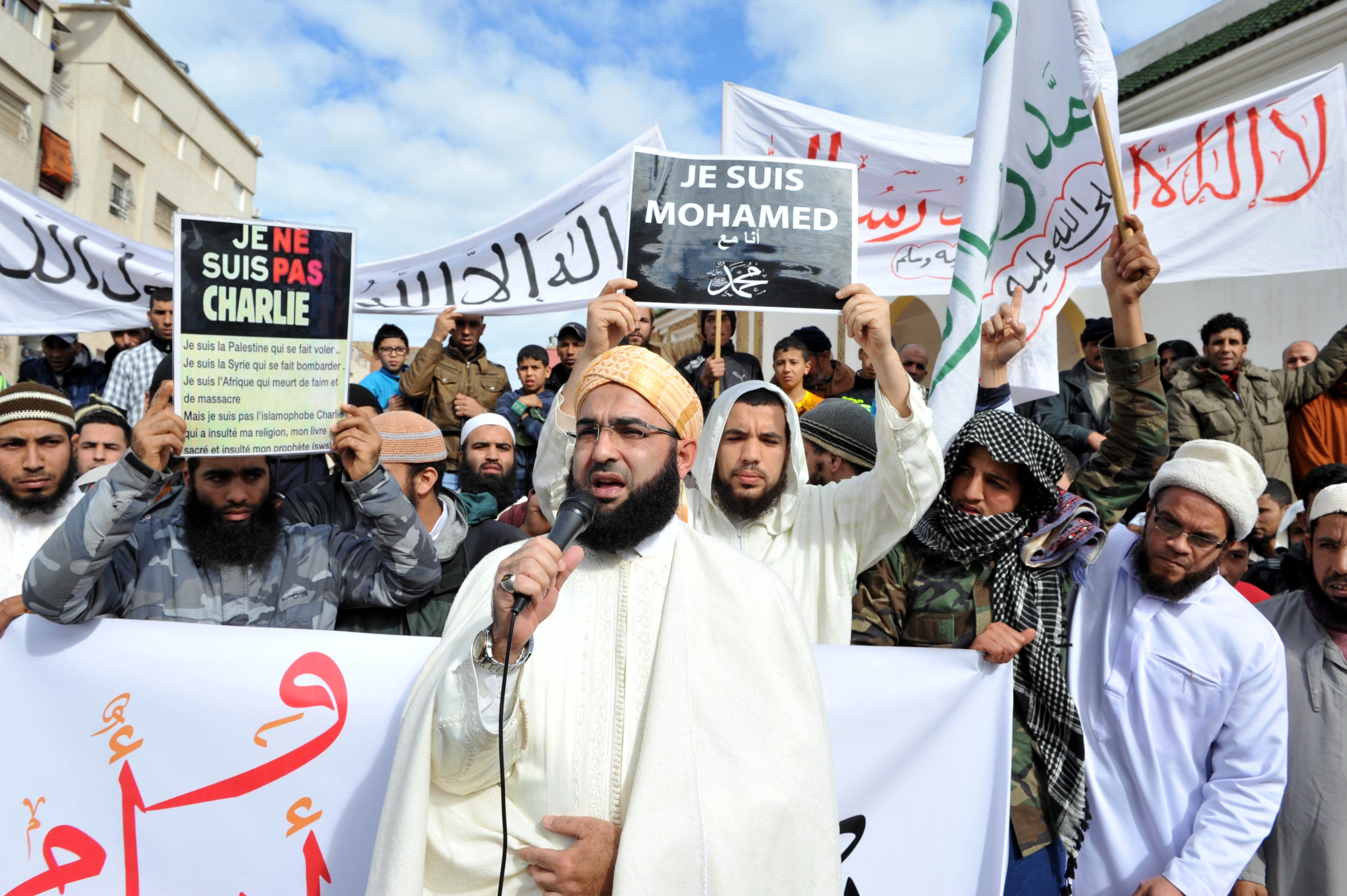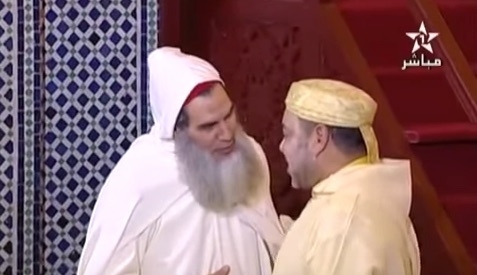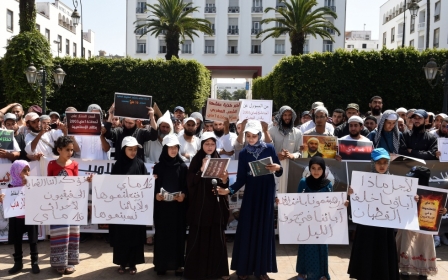Moroccan Salafists seek a voice in the political landscape

RABAT, Morocco - Several dozen Salafists came together on 10 December outside the Moroccan parliament building in the capital Rabat for International Human Rights Day. The group that unites them, the Joint Committee for Defence of Islamist Prisoners (CCDI), was created in 2011 in the wake of the 20 February movement.
On paper, this informal group consisting of approximately a thousand members - with a national office and several satellite offices across the various towns and cities in the country - pleads the case of Salafist prisoners, former prisoners and their families.
However, Abdelhakim Aboullouz, a researcher at the Jacques Berque Centre, told Middle East Eye that the group had broadened its activities as a Salafist rights group. “Gradually, the CCDDI has become the face of Moroccan activist Salafism. It is the only real group which exists for dissenting Salafists who want to have an influence in public life beyond simply religious issues.
‘It is the only real group which exists for dissenting Salafists who want to have an influence in public life beyond simply religious issues’
Abderrahim al-Ghazali, a spokesperson for the CCDDI who himself has spent two years in prison after breaking anti-terror laws, used well-tempered dialogue to give MEE a more limited definition of the organisation: “A setting to fight for human rights, specialising in the defence of Islamist prisoners and criticising anti-terror laws.”
For his part, Abou Khadifa Hamzaoui has never been to prison, but is a significant figure in the movement. In his small flat in Salé, in a working-class neighbourhood, this calm, slender activist, who wears a taguia (small round embroidered cap) on his head, states that the CCDDI is above all “the voice of prisoners”, but over time it has become somewhat the “voice of Salafists”.
“It is a considerable voice today, while more and more people who are suspected of terrorist activities or with terrorist sympathies are arrested,” added Aboullouz.
According to the CCDDI, around a thousand Salafists are behind bars. While the Central Office of Legal Investigations (BCIJ) has stated that 198 Moroccans returned from Syria last October, the CCDDI has replied that this figure does not include the spouses and children of fighters.
Isolated preachers
On the other hand, since the wave of releases that took place in 2011 following protests in the region and across the country, the question of political integration of Salafists and former prisoners has become ubiquitous. During the legislative elections last October, this was still talked about.
Declared intentions and contacts between the political parties and Shuyoukhs (plural of sheikh, a respected figure in Islam) are taking place. A very small party led by a retired commissioner welcomed Abdelkrim Chadili in 2015, a media figure who had been imprisoned.
Abou Hafs, a sheikh who was imprisoned in 2003 for his preaching, campaigned for his release with the Renaissance and Virtue Party (PRV), a small Islamist party which split from the governing Islamist Justice and Development Party (PJD).
The PRV openly talked with several other Shuyoukhs, without much success. Abou Hafs, whose discourse became much more tempered, finally stood for legislative elections in 2016 under the colours of Istiqlal, the nationalist conservative party. Cut off from the Salafist bases, after no longer receiving any support, the former radical sheikh did not take any of his former colleagues with him. The former stars of radical parties, in their repentance, distanced themselves from their own.
“Between 2011 and 2016, the policy of integration, above all based on adherence of the most influential Shuyoukhs, showed its limitations. They became domesticated religious people,” stated Aboullouz, and this while the risk of militant violence has become more of a threat than ever if we believe the official line, which regularly reports attacks that were only just thwarted.
Anti-PJD protest
The position for a politicised Salafist structure daring to enter the political field remained vacant. And independently, the CCDDI has begun to occupy it, on the strength of legitimacy which the Shuyoukhs lost during their reconciliation process. “Indeed, the discourse of the CCDDI is more outspoken, more radical and it appears to be the proper mix of reinsertion and loyalty to Salafist ideas,” explained Aboullouz.
The committee is multiplying the number of protests and ensuring media coverage of the most emblematic ones. It actively mobilised its troops for the release of Younes Chekkouri - freed from Guantánamo in September 2015 and once more imprisoned in Morocco before finally being released in February 2016. His release from prison was celebrated with great pomp by Hamzaoui and other supporters of the cause. “The CCDDI is an expert in communication, and uses the internet wisely. This allows it to ensure the visibility of its discourse in the public opinion,” stated Aboullouz.
In March 2016, the committee showed further proof of its modern activist expertise in a protest really close to the registered office of the PJD, to condemn the slow release of prisoners.
Activists from the CCDDI, with some participating in the protests held on 20 February, rubbed shoulders with activists from various backgrounds, liberals and left-wing included, and put on a small puppet show to mock Islamist leaders who they believe have become blind to their claims since entering the government.
Hamzaoui does not hide the fact he no longer has anything to do with Shuyoukhs who appear to be domesticated
This political event was quite something as it took place on a symbolic date. Exactly four years previously, on 25 March 2011, defenders of prisoners met with several representatives of the authorities to resolve the matter.
At the time, Mustafa Ramid, lawyer and one of the most active leaders of the PJD was at their side, and represented them in this meeting as the president of Mountada al Karama, an Islamist association for the defence of human rights. The latter, who became minister for justice in 2012, has since then never once referred to the matter aside for during a working meeting with members of the CCDDI the year he took office.
On this occasion, the CCDDI also publicly condemned several well-reputed Shuyoukhs released in 2011 and who had distanced themselves from the cause of prisoners.
Mohamed Fizazi, one of the leading celebrities of the most radical wing of Islamism prior to his release in 2011, was also portrayed in the puppet show. Before his imprisonment in 2003 he had stated just how much he detested the tawaghit regimes, but met with King Mohammed VI in 2014 in Tangiers.
Hamzaoui does not hide the fact that he no longer has anything to do with the Shuyoukhs who appear to him to be domesticated. “Some of them, in any case, no longer claim to be Salafists. They have taken their distance.”
Against Charlie, alongside the Prophet
However, the CCDDI, as well as playing the card of politicisation of prisoners and objection, goes much further than this issue alone in a clear and regular manner.
Consequently, in January 2015, the committees of the CCDDI in Sale, Sidi Slimane and Fes, organised protests under the banner “We are not Charlie Hebdo, we are with the Prophet Mohammed” after the attack against the satirical press publication in Paris, which brought together several hundred sympathisers.
More recently, activists from Larache, in the north of the country, organised an event to protest against a column written by journalist Abdelkrim El Qamch, appearing in the Arab speaking daily Akhir Saâ, which they believe “harmed the Prophet”.
The typical discourse which is gradually appearing, after several years of activities, is wavering between human right rhetoric and a more incisive Islamist vulgate
This was the chance for sympathisers of the CCDDI to gain some major media coverage, and for Omar Haddouchi, one of the rare Shuyoukhs to have repented without having neglected the fundamentals, to once more be seen in public with his brothers.
The typical discourse which is gradually appearing, after several years of activities, is wavering between human right rhetoric and more incisive Islamist interventions. The public pitch of thr group is summed up in the requirement for recognition of the “rights of Muslims” on International Human Rights Day. “It is a question which people are asking. Look at what is happening to Muslims in Burma, Syria, etc,” said Hamzaoui.
Distanced from IS
However concerns have been expressed about the discourse of the CCDDI, despite the press constantly covering news about the fight against IS. During protests organised by the committee in Tétouan, Sheikh Abderrazaq Ajaha, who was in prison in 2003 and prohibited from preaching, made the most of the chance to speak out, and used a certain amount of charisma to appear as a leader in Térouan, a northern city where the CCDDI is particularly powerful.
As an activist who is above all in favour of Moroccan fighters who are detained in Iraq, the latter has not hidden his admiration for Abu Bakr al-Baghdadi, nor his support for the self-proclaimed caliphate.
Mohamed Masbah, a researcher at the Chatham House centre and interviewed by MEE, noted “that many divergences appear within the CCDDI, which are very heterogenous”. Indeed, the tone set in protests for Syria are different from one city to the next, depending on the local figures and it is for instance much more radical in the north of Morocco, especially in Tétouan.
Hamzaoui indicated that “the local offices and members have much more freedom but it should be noted that Ajaha never had a role in the CCDDI and made his reputation online”.
As well as a quite clear hostility to IS projects, Hamzaoui, just as many of his brothers, mistrusts those who could harm the fight for prisoners and endanger the movement.
Activists regularly organise peaceful protests, at the exit of mosques in Fes or Tetouan, in support of Syria, not hiding away and coming together in support of all 'Muslims' - read Sunnis
The CCDDI had already distanced itself from one of its founders, the very radical Fatiha Mejjati, famous widow of the convicted militant Karim Mejjati. Her strategy of simply attacking from all angles, without any concessions, did not please many. Since then, Mejjati has emigrated to Syria and joined the self-proclaimed caliphate of IS.
The CCDDI is much more subtle. Its activists regularly organise peaceful protests, at the exit of mosques in Fes or Tetouan, in support of Syria, not hiding away and coming together in support of all “Muslims” - read Sunnis. And the majority of activists seem to be satisfied with the subtle discourse adopted by Sheikh Haddouchi in 2013, stating that jihad concerns Syrian Muslims, not Moroccans. This is a way of rejecting the militant concept of jihad, without breaking the law.
The CCDDI is able to moderate its activists. Without any over-zealous complacency, there are several who operate the mourajaa (ideological review). And, above all, they automatically recognise the various sensibilities which define Moroccan society.
Hamzaoui, in March 2016, met with Abdelmalek Zaazaa, a lawyer close to the PJD, as well as the Marxist professor in philosophy Ahmed El Haijj, president of the very secular Moroccan Association of Human Rights (AMDH).
Issam Chouider, a serious activist who attends every protest, stated that “the dialogue with all of the parties ready to move matters forward for prisoners is welcome, whether with authorities or civil society, even if today our calls are still not heard”.
“The CCDDI is not a direct interlocutor of the authorities, even if each of them is able to gauge the other. However, in the space of a few years, it has been able to impose itself in the media and in civil society, between its radical discourse and flexibility in its militant practices,” stated Aboullouz.
Haloui, the missing figure
Today, the CCDDI allows its volatile Salafist bases, often pugnacious and stirring, to train in peaceful activism. “This structure has become the most attractive offer for young Salafists and it can be noted that its influence has gradually rolled out,” noted Aboullouz.
Anything that has a meaning, if we believe Masbah, is worth something to the authorities: “It allows any dangerous frustration to be avoided, by preventing Salafists from making any speeches, whilst keeping a close eye on them.”
With the best will in the world, the CCDDI cannot prevent people from leaving for Syria. One of the founders of the committee and its spokesperson, the thirty-something Anas Haloui, was renowned for his ease of dialogue and open-mindedness. In the portrait most often used of him by the Moroccan press, it is clear to see, behind his face, the logo of the left-wing AMDH.
Despite the best will in the world, the CCDDI cannot prevent people from leaving for Syria.
Haloui grew weary and events in Syria caught up with him. The former prisoner, who appeared to have settled down, left for Syria in December 2013 to fight alongside Harakat Cham al-Islam, a group of Moroccan fighters with links to al-Qaeda.
The group, classified as a terrorist group by the US, was founded by Ibrahim Benchekroun, who was in prison and could be seen in several meetings of the CCDDI.
In Syria, Haloui soon died. “This gesture was only about him. It was a personal choice,” noted Hamzaoui.
Before leaving, Haloui took great care to publicly distance himself from the committee and left his office, protecting the image of the structure of which he had been one of the founding fathers.
New MEE newsletter: Jerusalem Dispatch
Sign up to get the latest insights and analysis on Israel-Palestine, alongside Turkey Unpacked and other MEE newsletters
Middle East Eye delivers independent and unrivalled coverage and analysis of the Middle East, North Africa and beyond. To learn more about republishing this content and the associated fees, please fill out this form. More about MEE can be found here.






